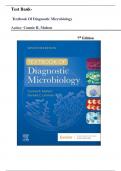Test Bank-
Textbook Of Diagnostic Microbiology
Author: Connie R. Mahon
7th Edition
, Mahon: Textbook Of Diagnostic Microbiology, 7th Edition Test Bank
Table Of Contents
Part 1: Introduction To Clinical Microbiology
Chapter 1. Bacterial Cell Structure, Physiology, Metabolism, And Genetics
Chapter 2. Host-Parasite Interaction
Chapter 3. The Laboratory Role In Infection Control
Chapter 4. Control Of Microorganisms: Disinfection, Sterilization, And Microbiology Safety
Chapter 5. Performance Improvement In The Microbiology Laboratory
Chapter 6. Specimen Collection And Processing
Chapter 7. Microscopic Examination Of Materials From Infected Sites
Chapter 8. Use Of Colony Morphology For The Presumptive Identification Of Microorganisms
Chapter 9. Biochemical Identification Of Gram-Negative Bacteria
Chapter 10. Immunodiagnosis Of Infectious Diseases
Chapter 11. Applications Of Molecular Diagnostics
Chapter 12. Antibacterial Mechanisms Of Action And Bacterial Resistance Mechanisms
Chapter 13. Antimicrobial Susceptibility Testing
Part 2: Laboratory Identification Of Significant Isolates
Chapter 14. Staphylococci
Chapter 15. Streptococcus, Enterococcus, And Other Catalase-Negative, Gram-Positive Cocci
Chapter 16. Aerobic Gram-Positive Bacilli
Chapter 17. Neisseria Species And Moraxella Catarrhalis
Chapter 18. Haemophilus, HACEK, Legionella And Other Fastidious Gram-Negative Bacilli
Chapter 19. Enterobacteriaceae
Chapter 20. Vibrio, Aeromonas, And Campylobacter Species
Chapter 21. Nonfermenting And Miscellaneous Gram-Negative Bacilli
Chapter 22. Anaerobes Of Clinical Importance
Chapter 23. The Spirochetes
Chapter 24. Chlamydia, Rickettsia, And Similar Organisms
Chapter 25. Mycoplasma And Ureaplasma
Chapter 26. Mycobacterium Tuberculosis And Nontuberculous Mycobacteria
Chapter 27. Medically Significant Fungi
Chapter 28. Diagnostic Parasitology
Chapter 29. Clinical Virology
Chapter 30. Agents Of Bioterror And Forensic Microbiology
Chapter 31. Biofilms: Architects Of Disease
Part 3: Laboratory Diagnosis Of Infectious Diseases: And Organ System Approach To Diagnostic
Microbiology
Chapter 32. Upper And Lower Respiratory Tract Infections
Chapter 33. Skin And Soft Tissue Infections
Chapter 34. Gastrointestinal Infections And Food Poisoning
Chapter 35. Infections Of The Central Nervous System
Chapter 36. Bacteremia And Sepsis
Chapter 37. Urinary Tract Infections
Chapter 38. Genital Infections And Sexually Transmitted Infections
Chapter 39. Infections In Special Populations
Chapter 40. Zoonotic Diseases
Chapter 41. Ocular Infections
-
,Chapter 01: Bacterial Cell Structure, Physiology, Metabolism, And
GeneticsMahon: Textbook Of Diagnostic Microbiology, 7th Edition Test
Bank
MULTIPLE CHOICE
1. To Survive, Microbial Inhabitants Have Learned To Adapt By Varying All Of The Following, Except
a. Growth Rate.
b. Growth In All Atmospheric Conditions.
c. Growth At Particular Temperatures.
d. Bacterial Shape.
ANSWER: D
The Chapter Begins By Discussing The Way Microbial Inhabitants Have Had To Evolve To
SurviveIn Many Different Niches And Habitats. It Discusses Slow Growers, Rapid Growers,
And Replication With Scarce Or Abundant Nutrients, Under Different Atmospheric
Conditions, Temperature Requirements, And Cell Structure. Bacterial Shape As A Form Of
Evolution Is Not Discussed.
OBJ: Level 2: Interpretation
2. Who Was Considered The Father Of Protozoology And Bacteriology?
a. Anton Van Leeuwenhoek
b. Louis Pasteur
c. Carl Landsteiner
d. Michael Douglas
ANSWER: A
The Book Discusses Anton Van Leeuwenhoek As The Inventor Of The Microscope And
The First Person To See The “Beasties.” So They Dubbed Him The Father Of Protozoology
And Bacteriology.The Other Three Individuals Were Not Discussed.
OBJ: Level 1: Recall
3. Prokaryotic Cells Have Which Of The Following Structures In Their Cytoplasm?
a. Golgi Apparatus
b. Ribosomes
c. Mitochondria
d. Endoplasmic Reticulum
ANSWER: B
All The Structures Listed Are Found In Eukaryotic Cells, But Ribosomes Are The Only
Ones ThatApply To Prokaryotic Cells.
OBJ: Level 1: Recall
4. This Form Of DNA Is Commonly Found In Eukaryotic Cells.
a. Linear
b. Circular
c. Plasmid
d. Colloid
Ultimatestudyguide2021@Gmail.Com
Testbanks/ Solution Manuals And Exam
, ANSWER: A
Circular And Plasmid DNA Are Usually Found Only In Bacteria, Not Eukaryotic Cells.
Colloid IsA Property Of Protein Molecules And Is Not Associated With Nucleotides.
OBJ: Level 1: Recall
5. The Nuclear Membrane In Prokaryotes Is
a. Missing.
b. Impenetrable.
c. A Classic Membrane.
d. A Lipid Bilayer Membrane.
ANSWER: A
Prokaryotic Cells Do Not Have Any Membrane-Bound Structures In The Cytoplasm
Including AStructured Nucleus.
OBJ: Level 1: Recall
6. A Microorganism That Is A Unicellular Organism And Lacks A Nuclear Membrane
And TrueNucleus Belongs To Which Classification?
a. Fungi
b. Bacteria
c. Algae
d. Parasite
ANSWER: B
Fungi, Algae, And Parasites Are Unicellular Eukaryotic Organisms That Contain A True
Nucleus.Bacteria Are Prokaryotic And Do Not Contain A True Nucleus Or Nuclear
Membrane.
OBJ: Level 1: Recall
7. In The Laboratory, The Clinical Microbiologist Is Responsible For All The Following, Except
a. Isolating Microorganisms.
b. Selecting Treatment For Patients.
c. Identifying Microorganisms.
d. Analyzing Bacteria That Cause Disease.
ANSWER: B
Clinical Microbiologists Do Not Select The Treatment For Patients. They Provide The
Doctor WithThe Name Of The Organism And The Antibiotics That Can Kill The Bacteria,
But Not In The Final Selection Of Treatment Protocols.
OBJ: Level 2: Recall
8. What Enables The Microbiologist To Select The Correct Media For Primary Culture And
OptimizeThe Chance Of Isolating A Pathogenic Organism?
a. Determining Staining Characteristics
b. Understanding The Cell Structure And Biochemical Pathways Of An Organism
c. Understanding The Growth Requirements Of Potential Pathogens At Specific Body Site
d. Knowing The Differences In Cell Walls Of Particular Bacteria
ANSWER: C




